Changes in Water Environment in Erhai Lake and Its Influencing Factors
Abstract
1. Introduction
2. Study Area and Data
2.1. Study Area
2.2. Data
3. Methods
3.1. Correlation Analysis
3.2. Land-Use Transfer Matrix
4. Results
4.1. Dynamic Change in Water Volume
4.2. Dynamic Change in Water Quality
4.2.1. Time Change
4.2.2. Spatial Change
4.3. Influence of Precipitation and Temperature on Water Environment
4.3.1. Precipitation Change
4.3.2. Temperature Change
4.3.3. Relationship between Changes in Climate Factors and Water Environment
4.4. Impact of Human Activities on Water Environment
4.4.1. Changes in Human Activities
4.4.2. Impact on Water Resources
4.4.3. Impact on Water Quality
5. Discussion
5.1. Influencing Factors of Water Volume Change
5.2. Influencing Factors of Water Quality Change
5.3. Future Work
6. Conclusions
- (1)
- From 2000 to 2019, the water volume of Erhai Lake fluctuated greatly, showing an overall upward trend, with a change trend of 3.8 × 106m3 year−1. The annual change in water volume showed a trend of first decreasing and then increasing. It increased from August to November and decreased from December to July.
- (2)
- From 2000 to 2019, the TN concentration in Erhai Lake showed an increasing trend. Among the monthly variations, the nitrogen concentration reached the highest value in August, and the value from August to December was higher than that from January to July. Spatially, the concentration of TN was the highest in the north, followed by that in the south, and it was lowest in the middle. In the same section, the concentration of TN was higher at the nearshore point and lower at the lake center point.
- (3)
- The interannual variation in Erhai Lake water was mainly affected by annual precipitation, and there was a significant positive correlation between precipitation and water volume (p < 0.05), with a correlation coefficient of 0.577. Monthly water volume was affected by climate factors and river water regimes. During the study period, the water consumption of the Erhai Lake basin showed a downward trend, and the impact of water consumption on water volume was small.
- (4)
- From 2000 to 2019, the change in land-use types in the Erhai Lake basin was mainly manifested by the increase in agricultural and construction land, the increase in agricultural land was mainly distributed in the north of the basin, the increase in construction land was distributed around Erhai Lake and Dali city, and the GDP and population increased significantly in the area where the construction land increased. In the north of the basin, human activities were mainly manifested as agricultural development, while in the south, human activities were mainly reflected by the acceleration of economic growth and urbanization.
- (5)
- The correlation between water quality change and climate factors was small, and the correlation between water quality change and human activities was large. In the northern part of the basin, agricultural nonpoint source pollution was the main factor affecting water quality, while in the southern part of the basin, economic development, accelerated urbanization, and tourism were the main factors affecting water quality.
Author Contributions
Funding
Institutional Review Board Statement
Informed Consent Statement
Data Availability Statement
Acknowledgments
Conflicts of Interest
References
- Yang, G.S.; Ma, R.H.; Zhang, L.; Jiang, J.H.; Yao, S.C.; Zhang, M.; Zeng, H.A. Lake status, major problems and protection strategy in China. Lake Sci. 2010, 22, 799–810. [Google Scholar]
- Bryant, M. Global climate change and potential effects on Pacific salmonids in freshwater ecosystems of southeast Alaska. Clim. Change 2009, 95, 169–193. [Google Scholar] [CrossRef]
- Li, L.; Wang, W. The response of lake change to climate fluctuation in north Qinghai-Tibet Plateau in last 30 years. J. Geogr. Sci. 2009, 19, 131–142. [Google Scholar]
- Hinkel, K.M.; Jones, B.M.; Eisner, W.R.; Cuomo, C.J.; Beck, R.A.; Frohn, R. Methods to assess natural and anthropogenic thaw lake drainage on the western Arctic coastal plain of northern Alaska. J. Geophys. Res. 2007, 112, F02S16. [Google Scholar] [CrossRef]
- Smith, L.C.; Sheng, Y.; Macdonald, C.M.; Hinzman, L.D. Disappearing Arctic Lakes. Science 2005, 308, 1429. [Google Scholar] [CrossRef]
- Ludwig, F.; Slobbe, E.V.; Cofino, W. Climate change adaptation and integrated water resource management in the water sector. J. Hydrol. 2014, 518, 235–242. [Google Scholar] [CrossRef]
- Destouni, G.; Asokan, S.M.; Jarsjö, J. Inland hydro-climatic interaction: Effects of human water use on regional climate. Geophys. Res. Lett. 2010, 37, 389–390. [Google Scholar] [CrossRef]
- Feng, L.; Han, X.X.; Hu, C.M.; Chen, X.L. Four decades of wetland changes of the largest freshwater lake in China: Possible linkage to the Three Gorges Dam? Remote Sens. Environ. 2016, 176, 43–55. [Google Scholar] [CrossRef]
- Xie, Z.; Huete, A.; Cleverly, J.; Phinn, S.; Qin, F. Multi-climate mode interactions drive hydrological and vegetation responses to hydroclimatic extremes in australia. Remote Sens. Environ. 2019, 231, 111270. [Google Scholar] [CrossRef]
- Siddique-E-Akbor, A.H.M.; Hossain, F.; Lee, H.; Shum, C.K. Inter-comparison study of water level estimates derived from hydrodynamic–hydrologic model and satellite altimetry for a complex deltaic environment. Remote Sens. Environ. 2011, 115, 1522–1531. [Google Scholar] [CrossRef]
- Wang, X.Q.; He, F.; Zhang, B. Study on the relationship between economic growth and environmental degradation of Lijiang cit. Geogr. Res. 2010, 29, 927–934. [Google Scholar]
- Sun, C.; Romero, L.; Joseph-Duran, B.; Meseguer, J.; Muñoz, E.; Guasch, R.; Martinez, M.; Puig, V.; Cembrano, G. Integrated pollution-based real-time control of sanitation systems. J. Environ. Manag. 2020, 269, 110798. [Google Scholar] [CrossRef] [PubMed]
- Zhao, M.; Cheng, W.M.; Zhou, C.H.; Li, M.C.; Wang, N.; Liu, Q.Y. GDP Spatialization and Economic Differences in South China Based on NPP-VIIRS Nighttime Light Imagery. Remote Sens. 2017, 9, 673. [Google Scholar] [CrossRef]
- Yang, X.C.; Yue, W.Z.; Gao, D.W. Spatial improvement of human population distribution based on multi-sensor remote-sensing data: An input for exposure assessment. Int. J. Remote Sens. 2013, 34, 5569–5583. [Google Scholar] [CrossRef]
- Zeng, C.Q.; Zhou, Y.; Wang, S.X.; Yan, F.L.; Zhao, Q. Population spatialization in China based on night-time imagery and land use data. Int. J. Remote Sens. 2011, 32, 9599–9620. [Google Scholar] [CrossRef]
- Ni, Z.K.; Wang, S.R.; Jin, X.C.; Jiao, L.X.; Li, Y.J. Study on the evolution and characteristics of eutrophication in the typical lakes on Yunnan-Guizhou Plateau. Acta Sci. Circumstantiae 2011, 31, 2681–2689. [Google Scholar]
- Wang, S.; Zhang, L.I.; Ni, L.; Zhao, H.; Jiao, L.; Yang, S.; Guo, L.; Shen, J. Ecological degeneration of the Erhai Lake and prevention measures. Environ. Earth Sci. 2015, 74, 3839–3847. [Google Scholar] [CrossRef]
- Shang, X.; Wang, X.; Zhang, D.; Chen, W.; Chen, X.; Kong, H. An improved SWATbased computational framework for identifying critical source areas for agricultural pollution at the lake basin scale. Ecol. Model. 2012, 226, 1–10. [Google Scholar] [CrossRef]
- Huang, H.J.; Wang, Y.P.; Li, Q.H. Climatic Characteristics over Erhai Lake Basin in the Last 50 Years and the impact on Water Resources of Erhai Lake. Meteorol. Mon. 2013, 34, 436–442. [Google Scholar]
- Li, Y.; Liu, H.B.; Lei, Q.L.; Hu, W.L.; Wang, H.Y.; Zhai, L.M.; Ren, T.Z.; Lian, H.S. Impact of Human Activities on Net Anthropogenic Nitrogen Inputs ( NANI) at Township Scale in Erhai Lake Basin. Environ. Sci. 2018, 39, 4189–4198. [Google Scholar]
- Wang, T.S.; Zheng, H. Analysis of Land Use and Landscape Pattern Change in Erhai Lake during Rapid Urbanization. Ecol. Econ. 2016, 32, 181–185. [Google Scholar]
- Ying, Y.Z.; Chu, Z.S.; Zhao, M.; Li, Z.K.; Ye, B.B.; Jin, X.C. Spatial and temporal changes in water quality in aquatic-terrestrial ecotone of Lake Erhai. China Environ. Sci. 2011, 31, 1192–1196. [Google Scholar]
- Yang, S.; Chen, X.; Lu, J.; Hou, X.; Xu, Q. Impacts of agricultural topdressing practices on cyanobacterial bloom phenology in an early eutrophic plateau lake, China. J. Hydrol. 2021, 594, 125952. [Google Scholar] [CrossRef]
- Sun, J.X.; Chen, J.; Huang, X.B. The bargain between subjects and rights negotiation in the tourism environmental governance issue of Erhai in Dali. Sci. Geogr. Sin. 2020, 40, 1468–1475. [Google Scholar]
- Zhang, Y.J.; Li, C.W.; Hu, B.B. Impact of a“source-sink” landscape pattern in an urbanized watershed on nitro⁃gen and phosphorus spatial variations in rivers: A case study of Yuqiao reservoir watershed, Tianjin, China. Acta Ecol. Sin. 2017, 37, 2437–2446. [Google Scholar]
- Ma, W.; Zhou, Y.; Su, J.G.; Jiang, R.C.; Hu, X.Q. Study on the hydrodynamic characteristics and transporation and diffusion of pollutants in Erhai lake. J. China Inst. Water Resour. Hydropower Res. 2021, 19, 1672–3031. [Google Scholar]
- Zhou, Z.D. Research on the calculation method of runoff of the Erhai ecological water demand and ecological needs. Annu. Meet. Yunnan Water Conserv. Soc. 2015, 6, 734–739. [Google Scholar]
- Xiao, Z.Y.; Shen, Z.C. The temporal and spatial evolution of population & industrial agglomeration and environmental pollution and the relevance analysis. J. Arid Land Resour. Environ. 2019, 33, 1–8. [Google Scholar]
- Verhoef, E.T.; Nijkamp, P. Externalities in urban sustainability: Environmental versus localization-type agglomeration externalities in ageneral spatial equilibrium model of a single-sector monocentric industrial city. Ecol. Econ. 2002, 40, 157–179. [Google Scholar] [CrossRef]
- Zhang, H.X. Analysis of Temporal and Spatial Changes of Total Nitrogen of Erhai Lake from 1985 to 2019. Environ. Sci. Surv. 2020, 39, 4–10. [Google Scholar] [CrossRef]
- Xiang, S.; Wu, Y.; Lv, X.J.; Gao, S.J.; Chu, Z.S.; Pang, Y. Characteristics and Spatial Distribution of Agricultural Non-Point Source Pollution in Erhai Lake Basin and Its Classified Control Strategy. Res. Environ. Sci. 2020, 33, 2474–2482. [Google Scholar]
- Wu, F.; Zhang, J.Y.; Deng, X.Y.; Ling, Y.Z. Influencing factors of lake eutrophication in China—A case study in 22 lakes in China. Ecol. Environ. Sci. 2012, 21, 94–100. [Google Scholar]
- Yang, K.L.; Ge, X.Y.; Dong, L.M. The Research between Social-Economic Development and Pollution Control of Erhai Lake. Ecol. Econ. 2011, 12, 37–40. [Google Scholar]
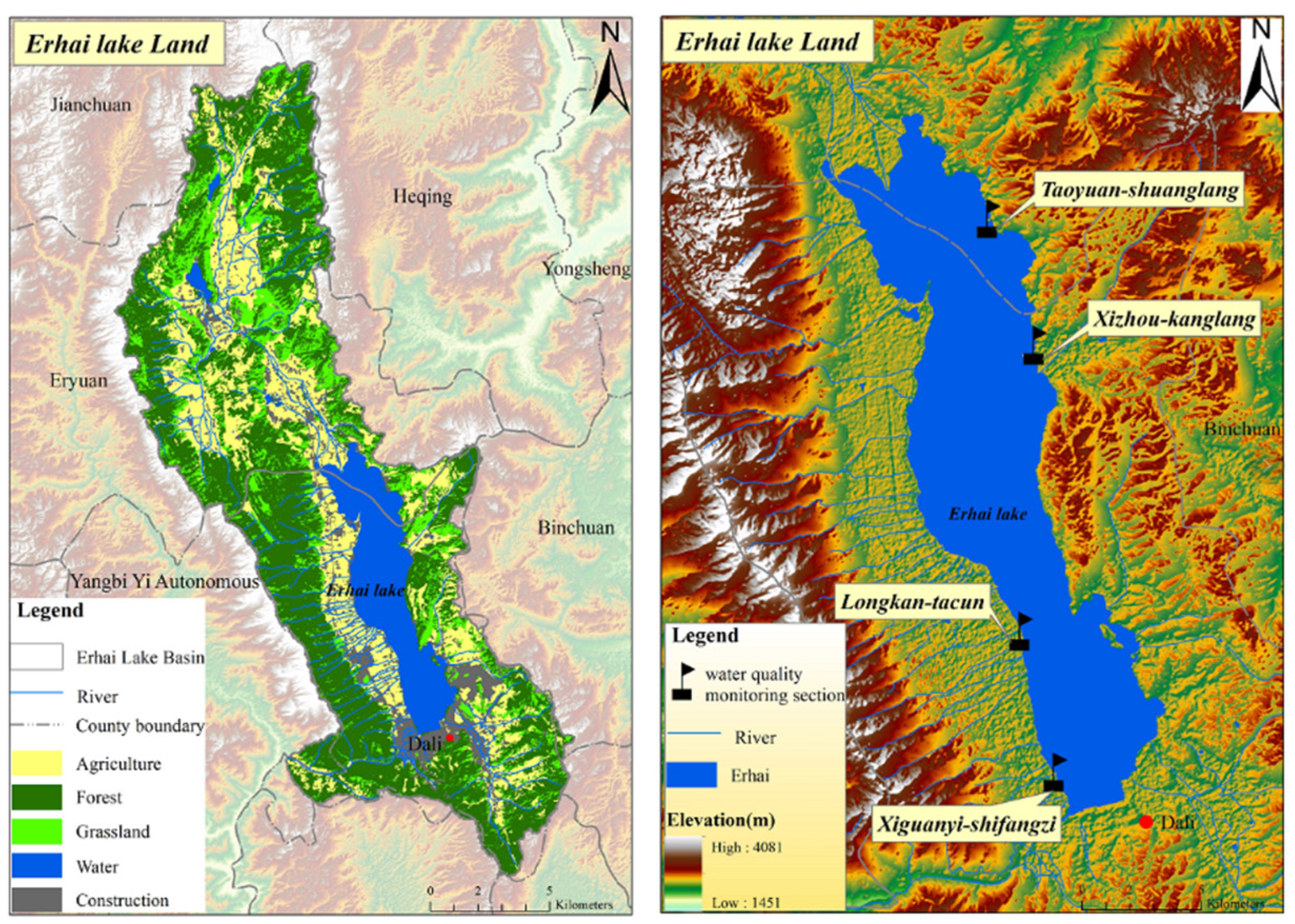
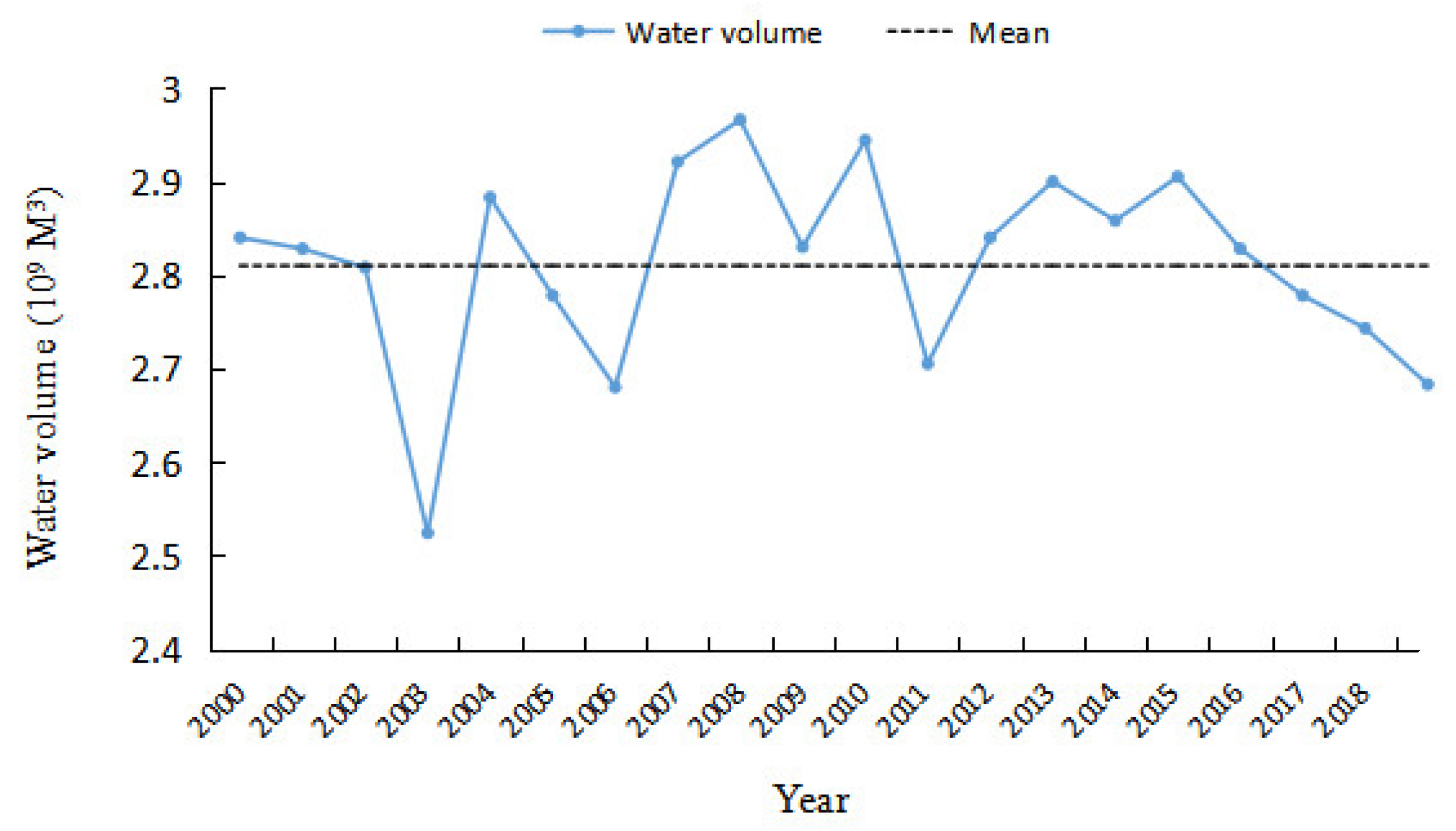
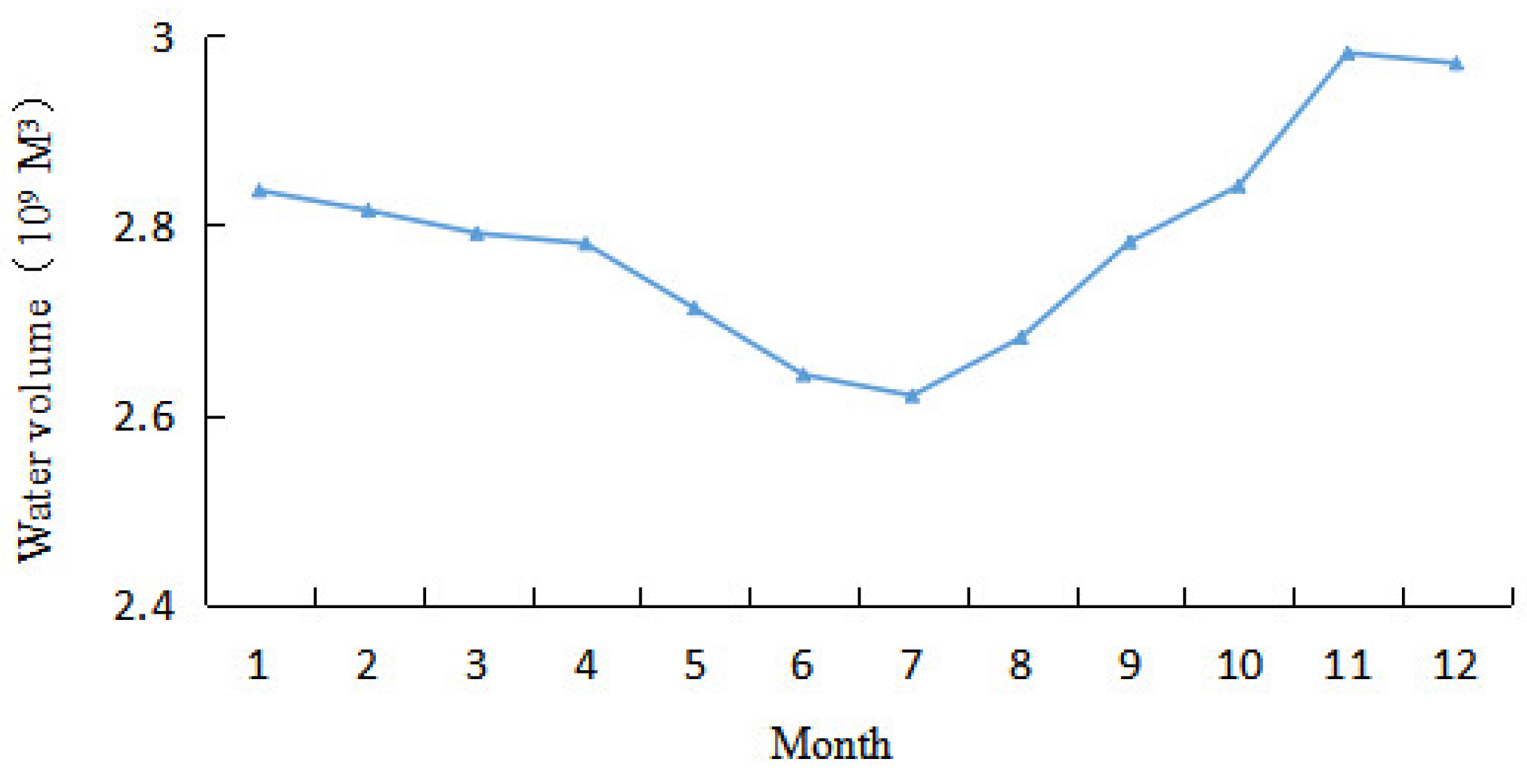

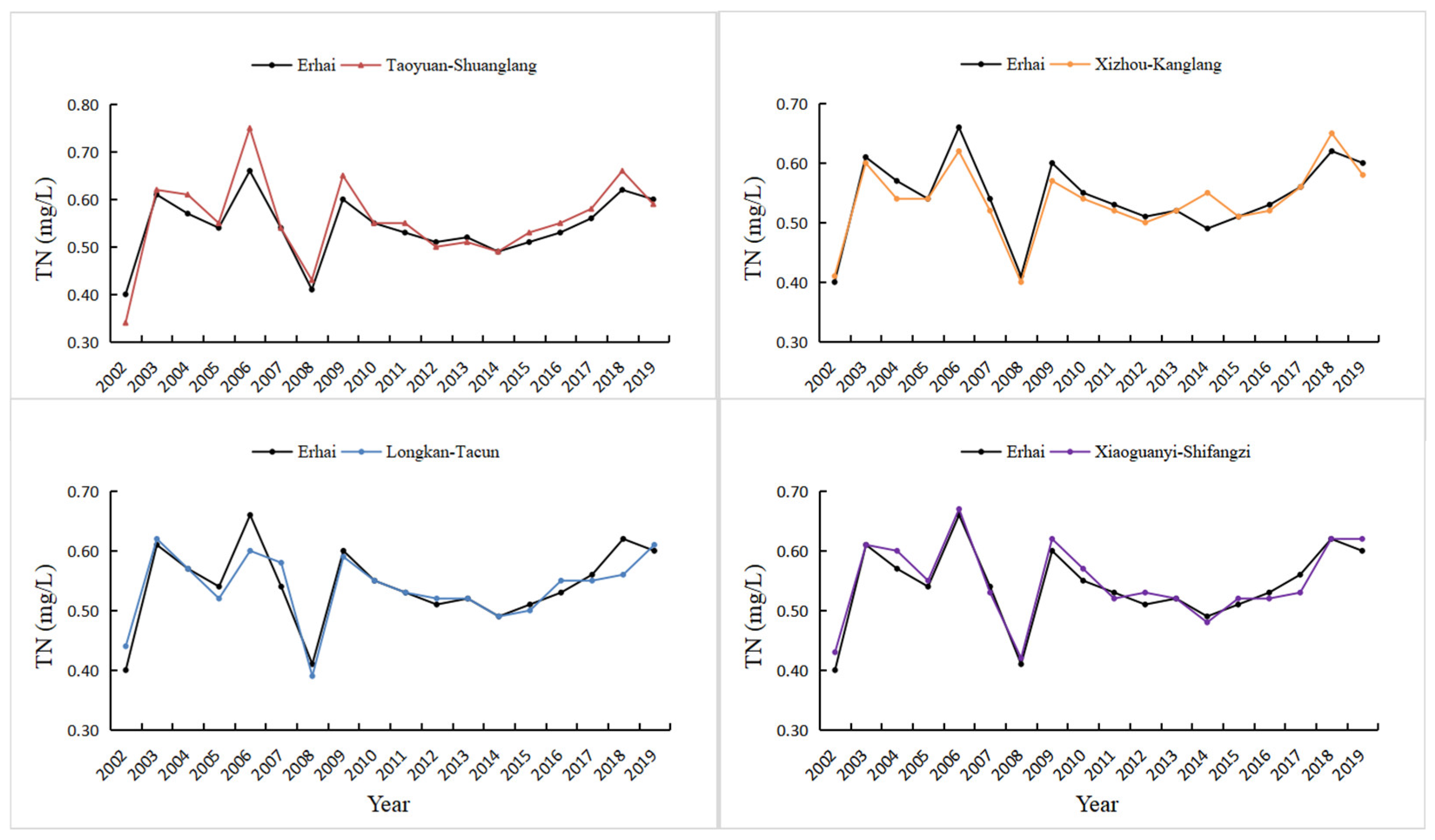

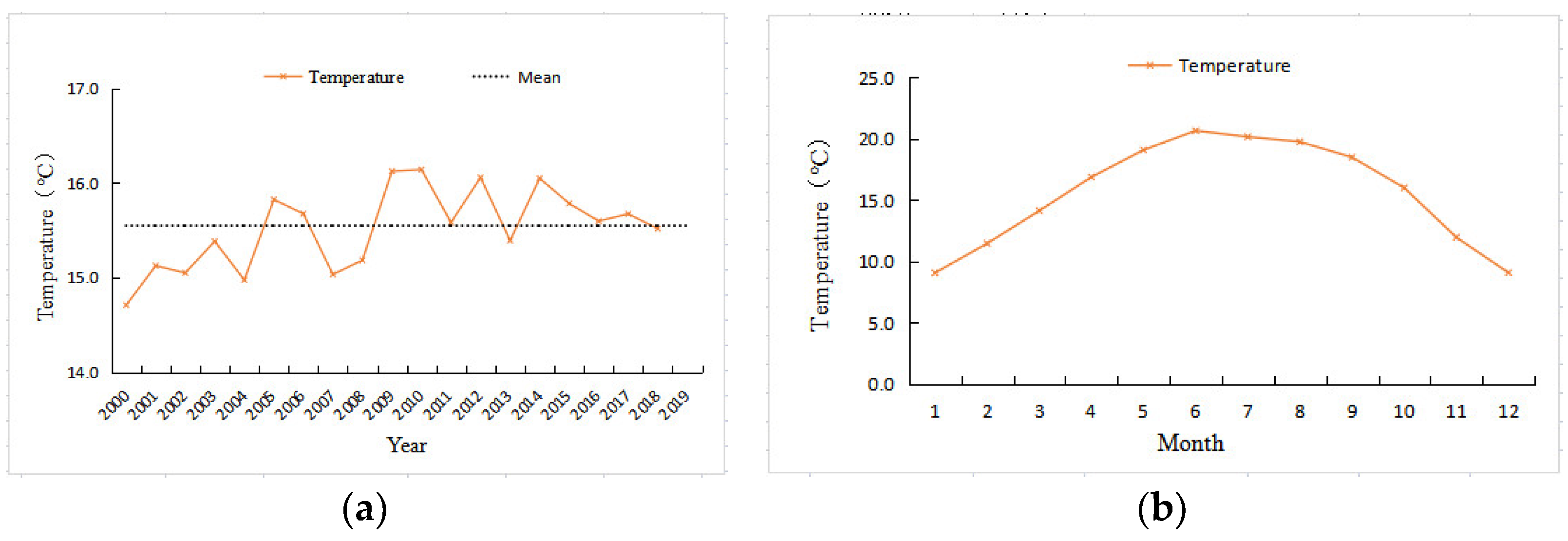
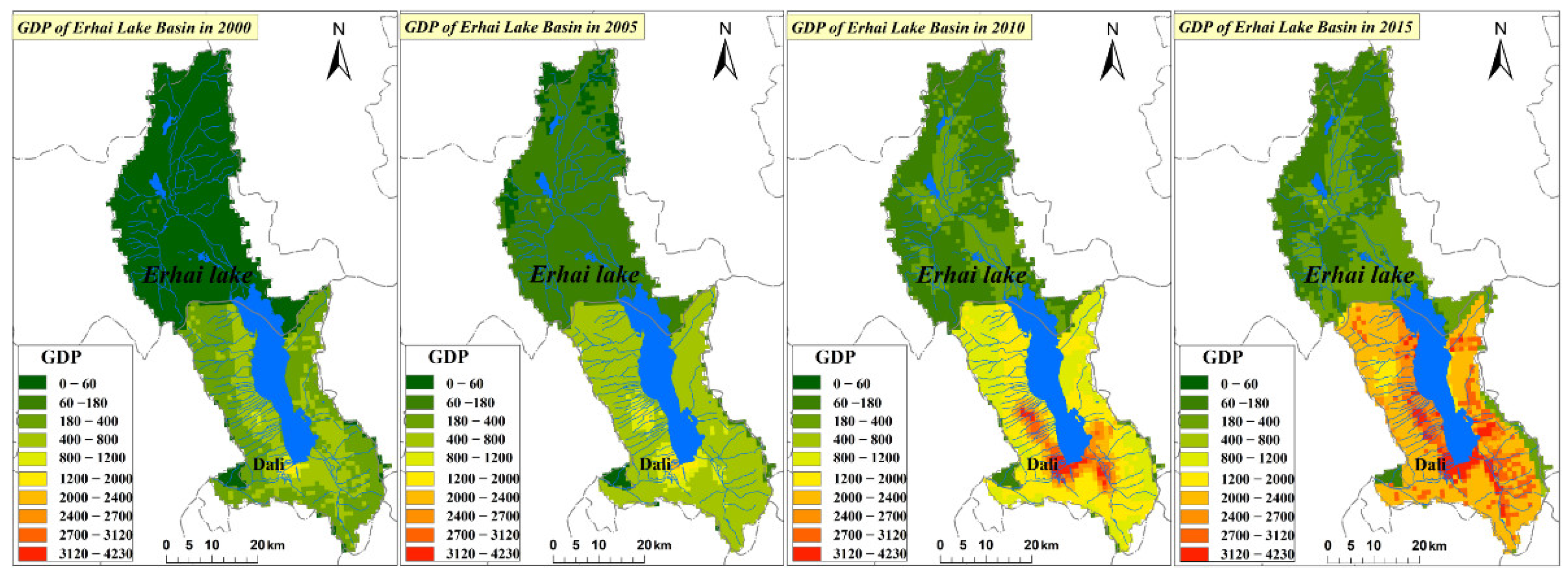
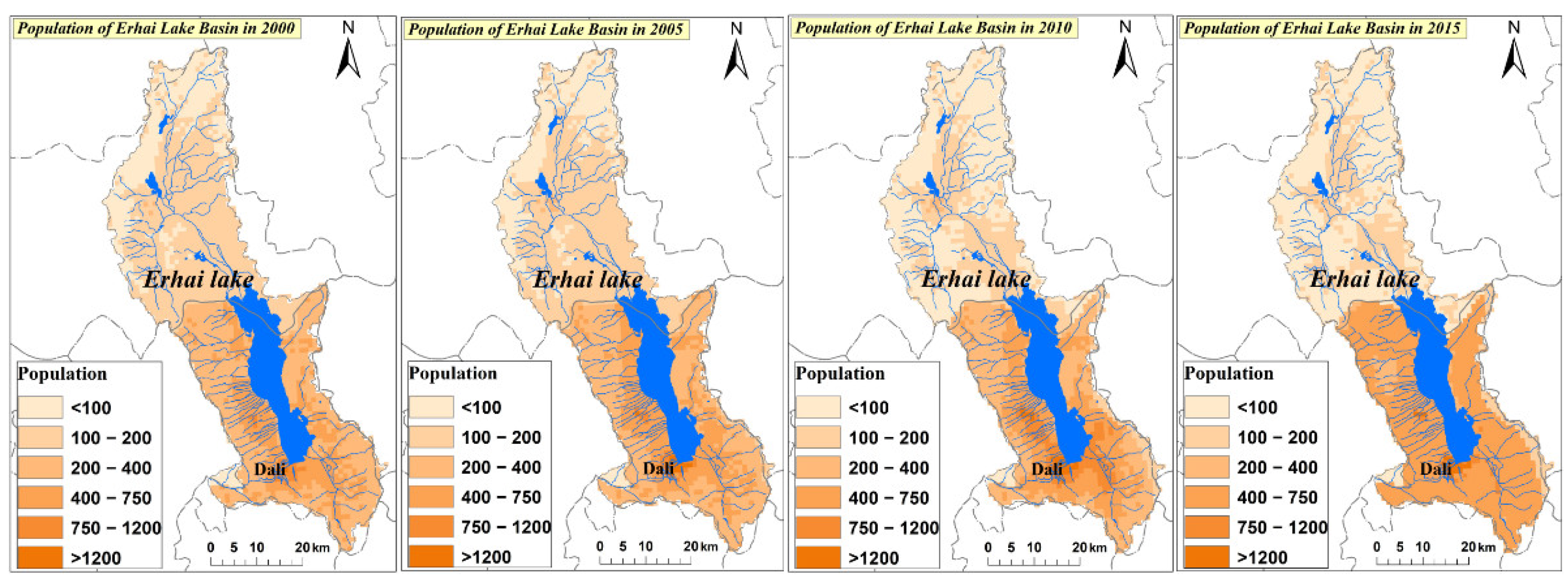
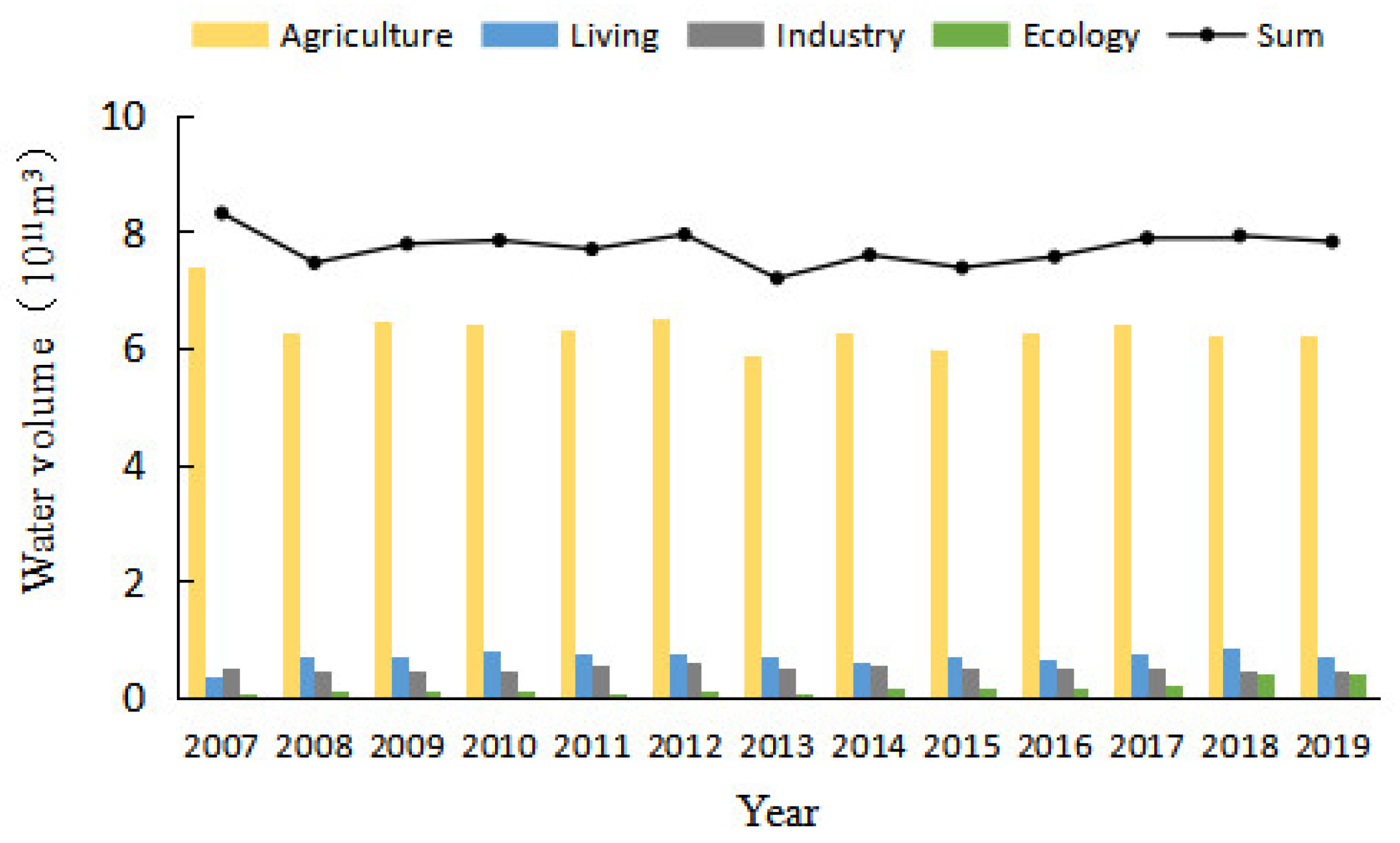
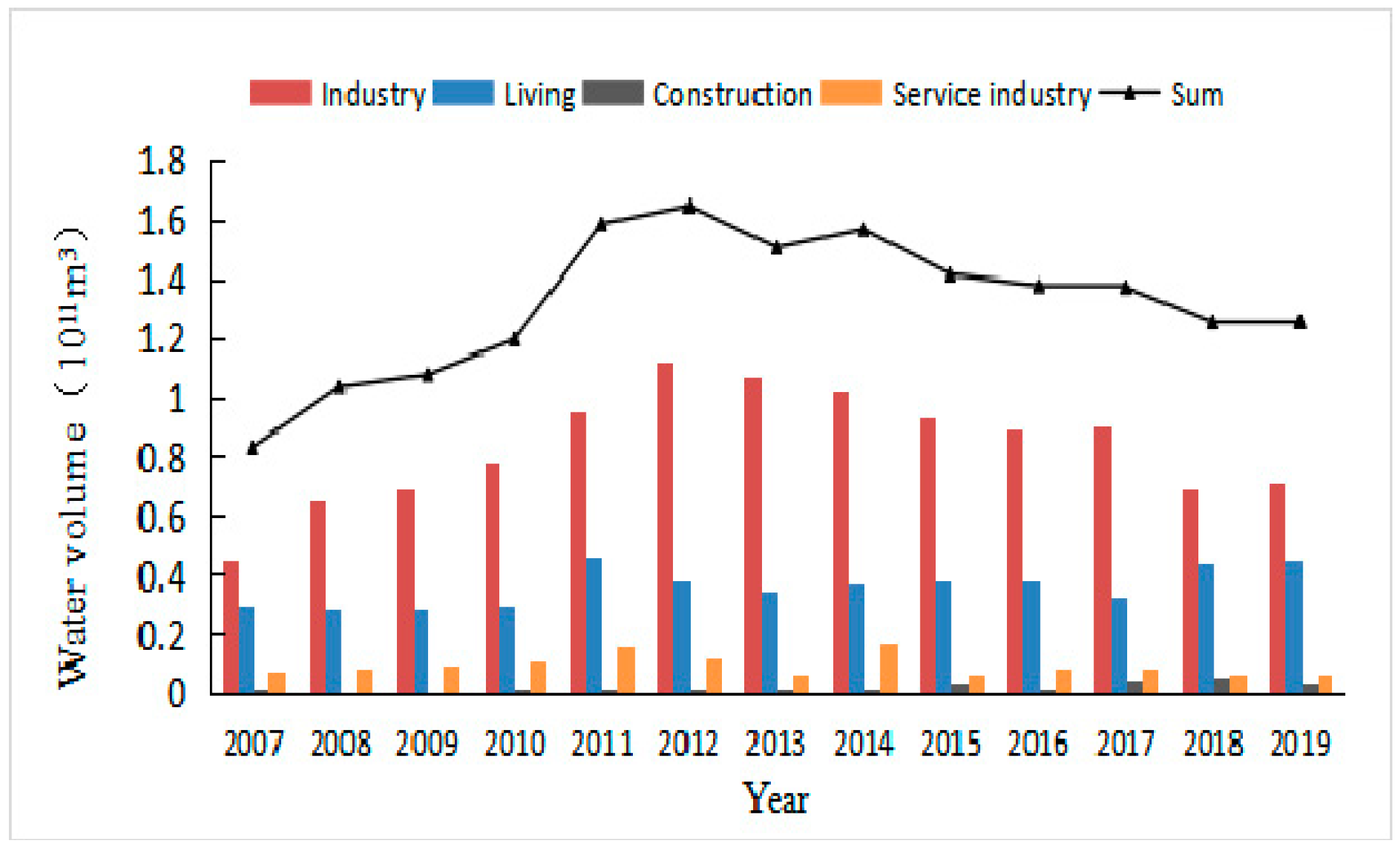
| Type | Time | Product | Source |
|---|---|---|---|
| GlobeLand30 | 2000, 2020 | Global land cover with 30 m spatial resolution | http://www.globallandcover.com/, accessed on 9 October 2020. |
| Meteorological data | 2000–2019 | Monthly precipitation and average temperature at meteorological stations | http://data.cma.cn/, accessed on 9 October 2020. |
| Statistical data | 2007–2019 | December water volume, water use structure, wastewater discharge data | http://www.dali.gov.cn/dlrmzf/c102607/common_list.shtml, accessed on 9 October 2020. |
| TN concentration | 2000–2019 | Annual and monthly TN concentration | http://www.cnemc.cn/, accessed on 9 October 2020. |
| GDP, population spatial distribution data | 2000, 2005, 2010, 2015 | 1 km spatial resolution | http://www.resdc.cn/Default.aspx, accessed on 9 October 2020. |
| Factor a | Factor b |
|---|---|
| Annual precipitation | water volume |
| Annual average temperature | water volume |
| Monthly precipitation | water volume |
| Monthly average temperature | water volume |
| Annual precipitation | TN concentration |
| Annual average temperature | TN concentration |
| Monthly precipitation | TN concentration |
| Monthly average temperature | TN concentration |
| water consumption | water volume |
| Water Volume | TN Concentration | |
|---|---|---|
| Annual precipitation | 0.577 (p < 0.01) | −0.09 |
| Annual average temperature | −0.113 | −0.049 |
| Monthly precipitation | −0.759 (p < 0.01) | 0.644 (p < 0.05) |
| Monthly average temperature | −0.841(p < 0.01) | 0.372 |
| 2020 | |||||||
|---|---|---|---|---|---|---|---|
| 2000 | Land-use type | Cultivated land | Forests | Grassland | Water | Construction land | Sum |
| Cultivated land | 49,992.75 | 2343.33 | 2576.43 | 215.01 | 6822 | 61,949.52 | |
| Forests | 3666.33 | 114,568.65 | 6472.71 | 66.06 | 1921.59 | 126,695.34 | |
| Grassland | 6253.29 | 6825.51 | 26,571.06 | 12.51 | 2061 | 41,723.37 | |
| Water | 163.53 | 300.69 | 89.82 | 25,536.06 | 94.14 | 26,184.24 | |
| Construction land | 2595.15 | 134.91 | 117.45 | 24.93 | 10,180.71 | 13,053.15 | |
| Sum | 62,671.05 | 124,173.09 | 35,827.47 | 25,854.57 | 21,079.44 | 269,605.62 | |
| Total | Agricultural | Living | Industrial | Eco-Environmental Supplemental | |
|---|---|---|---|---|---|
| Water volume | −0.22 | 0.163 | −0.324 | −0.126 | −0.658 (p < 0.05) |
Publisher’s Note: MDPI stays neutral with regard to jurisdictional claims in published maps and institutional affiliations. |
© 2021 by the authors. Licensee MDPI, Basel, Switzerland. This article is an open access article distributed under the terms and conditions of the Creative Commons Attribution (CC BY) license (https://creativecommons.org/licenses/by/4.0/).
Share and Cite
Zheng, L.; An, Z.; Chen, X.; Liu, H. Changes in Water Environment in Erhai Lake and Its Influencing Factors. Water 2021, 13, 1362. https://doi.org/10.3390/w13101362
Zheng L, An Z, Chen X, Liu H. Changes in Water Environment in Erhai Lake and Its Influencing Factors. Water. 2021; 13(10):1362. https://doi.org/10.3390/w13101362
Chicago/Turabian StyleZheng, Liang, Zeyu An, Xiaoling Chen, and Hai Liu. 2021. "Changes in Water Environment in Erhai Lake and Its Influencing Factors" Water 13, no. 10: 1362. https://doi.org/10.3390/w13101362
APA StyleZheng, L., An, Z., Chen, X., & Liu, H. (2021). Changes in Water Environment in Erhai Lake and Its Influencing Factors. Water, 13(10), 1362. https://doi.org/10.3390/w13101362







